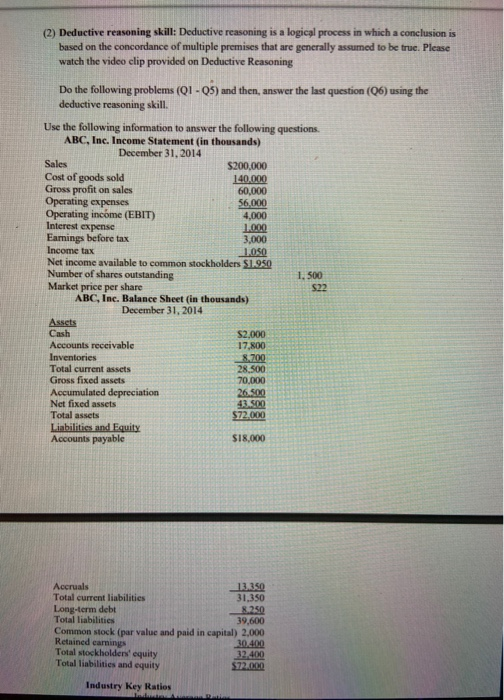(2) Deductive reasoning skill: Deductive reasoning is a logical process in which a conclusion is based on the concordance of multiple premises that are generally assumed to be true. Please watch the video clip provided on Deductive Reasoning Do the following problems (Q1-05) and then, answer the last question (Q6) using the deductive reasoning skill. Use the following information to answer the following questions ABC, Inc. Income Statement in thousands) December 31, 2014 Sales $200,000 Cost of goods sold 140.000 Gross profit on sales 60.000 Operating expenses 56.000 Operating income (EBIT) 4,000 Interest expense 1.000 Earnings before tax 3,000 Income tax 1,050 Net income available to common stockholders S1.950 Number of shares outstanding Market price per share ABC, Inc. Balance Sheet (in thousands) December 31, 2014 Assets Cash $2.000 Accounts receivable 17,800 Inventories 8.700 Total current assets 28 500 Gross fixed assets 70.000 Accumulated depreciation 26.500 Net fixed assets 43.500 Total assets $72.000 Liabilities and Equity Accounts payable Accruals 350 Total current liabilities 31.350 Long-term debt 8.250 Total liabilities 39.600 Common stock (par value and paid in capital) 2,000 Retained earnings 30.400 Total stockholders' equity 32.400 Total liabilities and equity $72.000 Industry Key Ratios Accruals 13,350 Total current liabilities 31,350 Long-term debt 8.250 Total liabilities 39,600 Common stock (par value and paid in capital) 2,000 Retained eamings 30.400 Total stockholders' equity 32,400 Total liabilities and equity $72.000 2.95 Industry Key Ratios Industry Average Ratios Current ratio Quick ratio 0.60 Days Sales Outstanding (DSO) 25 days Fixed assets turnover 5.8 Total asset turnover Liabilities-to-assets ratio 65% Times-interest-camed 3.2 Net profit margin 1.3% Return on equity 7.32% Price/earnings ratio 20.38 Market book ratio 3.19 1. Calculate current ratio and acid test ratio for the firm. 2 Calculate DSO, fixed assets turnover, and total asset turnover for the fimm 3. Calculate liabilities-to-assets ratio and times interest-eamed ratio for the firm. 4. Calculate net profit margin and return on equity for the firm. 5. Evaluate the performance of the firm in the following areas: Liquidity management Asset management Debt management Profitability management When you explain the firm's strength or weakness in each area, you must support your arguments through the evaluative reasoning process by providing reasons, methods criteria, or assumptions behind the claims made. 6. Deductive reasoning starts with a general principle and deduces that it applies to a specific case. Deductive reasoning moves with exacting precision from the assumed truth of a set of premises to a conclusion which cannot be false if those premises are true Explain the deductive reasoning process applied to analyze the firm's performance. (2) Deductive reasoning skill: Deductive reasoning is a logical process in which a conclusion is based on the concordance of multiple premises that are generally assumed to be true. Please watch the video clip provided on Deductive Reasoning Do the following problems (Q1-05) and then, answer the last question (Q6) using the deductive reasoning skill. Use the following information to answer the following questions ABC, Inc. Income Statement in thousands) December 31, 2014 Sales $200,000 Cost of goods sold 140.000 Gross profit on sales 60.000 Operating expenses 56.000 Operating income (EBIT) 4,000 Interest expense 1.000 Earnings before tax 3,000 Income tax 1,050 Net income available to common stockholders S1.950 Number of shares outstanding Market price per share ABC, Inc. Balance Sheet (in thousands) December 31, 2014 Assets Cash $2.000 Accounts receivable 17,800 Inventories 8.700 Total current assets 28 500 Gross fixed assets 70.000 Accumulated depreciation 26.500 Net fixed assets 43.500 Total assets $72.000 Liabilities and Equity Accounts payable Accruals 350 Total current liabilities 31.350 Long-term debt 8.250 Total liabilities 39.600 Common stock (par value and paid in capital) 2,000 Retained earnings 30.400 Total stockholders' equity 32.400 Total liabilities and equity $72.000 Industry Key Ratios Accruals 13,350 Total current liabilities 31,350 Long-term debt 8.250 Total liabilities 39,600 Common stock (par value and paid in capital) 2,000 Retained eamings 30.400 Total stockholders' equity 32,400 Total liabilities and equity $72.000 2.95 Industry Key Ratios Industry Average Ratios Current ratio Quick ratio 0.60 Days Sales Outstanding (DSO) 25 days Fixed assets turnover 5.8 Total asset turnover Liabilities-to-assets ratio 65% Times-interest-camed 3.2 Net profit margin 1.3% Return on equity 7.32% Price/earnings ratio 20.38 Market book ratio 3.19 1. Calculate current ratio and acid test ratio for the firm. 2 Calculate DSO, fixed assets turnover, and total asset turnover for the fimm 3. Calculate liabilities-to-assets ratio and times interest-eamed ratio for the firm. 4. Calculate net profit margin and return on equity for the firm. 5. Evaluate the performance of the firm in the following areas: Liquidity management Asset management Debt management Profitability management When you explain the firm's strength or weakness in each area, you must support your arguments through the evaluative reasoning process by providing reasons, methods criteria, or assumptions behind the claims made. 6. Deductive reasoning starts with a general principle and deduces that it applies to a specific case. Deductive reasoning moves with exacting precision from the assumed truth of a set of premises to a conclusion which cannot be false if those premises are true Explain the deductive reasoning process applied to analyze the firm's performance








